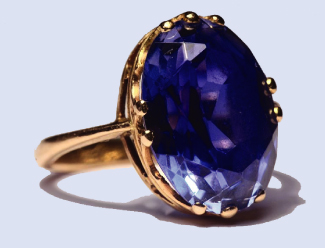Example 2.10: Predicting the Formula of an Ionic Compound
The gemstone sapphire ( Figure 31) is mostly a compound of aluminum and oxygen that contains aluminum cations, \(\ce{Al^3+}\), and oxygen anions, \(\ce{O^2-}\). What is the formula of this compound? Figure 31Although pure aluminum oxide is colorless, trace amounts of iron and titanium give blue sapphire its characteristic color. (credit: modification of work by Stanislav Doronenko)
Figure 31Although pure aluminum oxide is colorless, trace amounts of iron and titanium give blue sapphire its characteristic color. (credit: modification of work by Stanislav Doronenko)
Solution
Because the ionic compound must be electrically neutral, it must have the same number of positive and negative charges.\(\mathrm{Charge}_{\mathrm{\ce{Al^3+}}}\) \(= 3\)
\(\mathrm{Charge}_{\mathrm{\ce{O^2-}}}\) \(= -2\)
If you were to combine the ions in a 1:1 ratio, there would be an excess of positive charge.
Two aluminum ions, each with a charge of \(\ce{3+}\), would give us six positive charges, and three oxide ions, each with a charge of \(\ce{2-}\), would give us six negative charges. The formula and the dissociation equation would be
\(\ce{Al2O3}\)\(\ce{->}\)\(\ce{2 Al^3+}\)\(\ce{ + }\)\(\ce{3 O^2-}\)\(\ce{ }\)
You can figure out that both the left hand side and the right hand side have a total charge of zero, either by looking at the chemical equation above or by using the calculator (see below):
\(\mathrm{Charge}_{\mathrm{total}} = ν_{\mathrm{\ce{Al^3+}}} \cdot \mathrm{Charge}_{\mathrm{\ce{Al^3+}}} + ν_{\mathrm{\ce{O^2-}}} \cdot \mathrm{Charge}_{\mathrm{\ce{O^2-}}} = 0\)
\(ν_{\mathrm{\ce{Al^3+}}}\) \(= 2\)
\(ν_{\mathrm{\ce{O^2-}}}\) \(= 3\)
\(\mathrm{Charge}_{\mathrm{total}}\) \(= ν_{\mathrm{\ce{Al^3+}}} \cdot \mathrm{Charge}_{\mathrm{\ce{Al^3+}}} + ν_{\mathrm{\ce{O^2-}}} \cdot \mathrm{Charge}_{\mathrm{\ce{O^2-}}}\)
\(\ \ \ =2 \cdot 3 + 3 \cdot (-2)\)
\(\ \ \ =6 + -6\)
\(\ \ \ =0\)